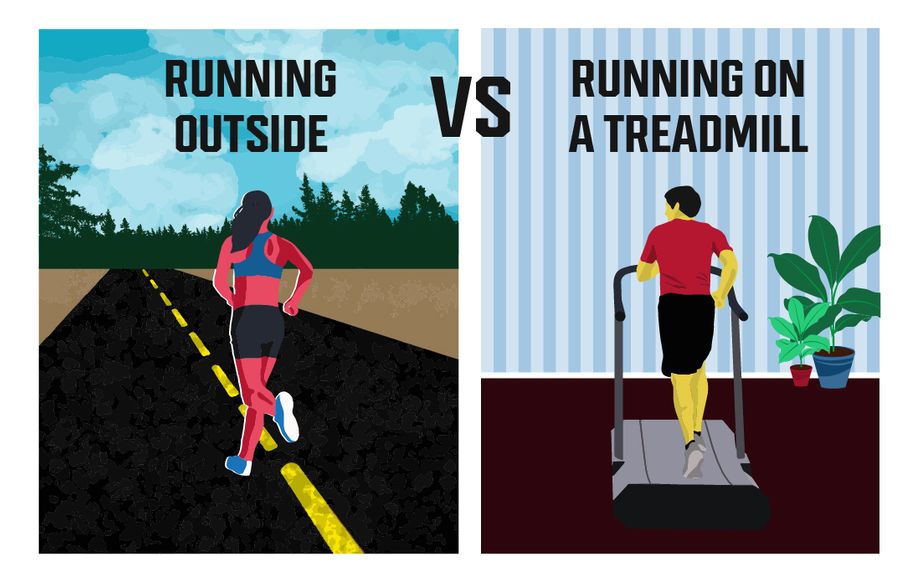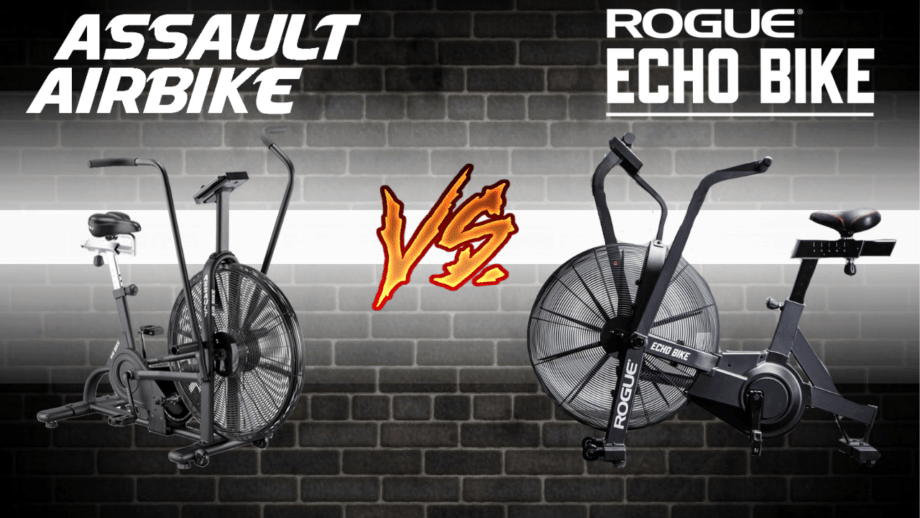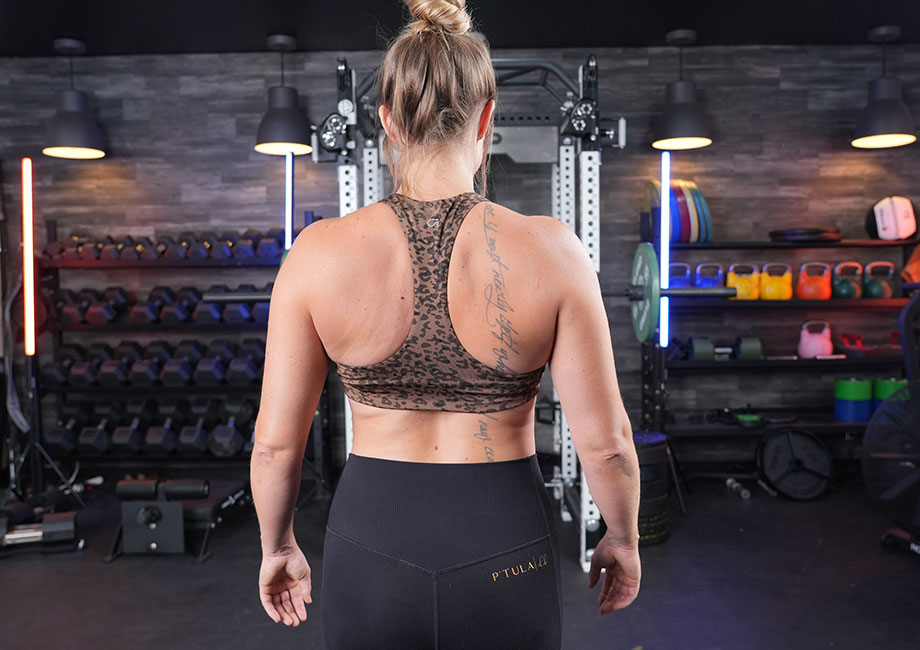Ending an Age-Old Debate
The running outside versus treadmill debate is not new, and every runner has their preference. Proponents on both sides share a love of running but tend to have strong feelings about why one form of running is better than the other.
Science can help us get a better understanding of why running on a treadmill is different from running outside, but which one is “better” ultimately depends on the runner’s goals, preferences, health needs, and accessibility to outside routes and gyms.
In this guide to running outside versus on a treadmill, Jacob Penner, a former track and field coach and certified personal trainer, explains the differences to help you decide which type of running workout is best for you.
Medical disclaimer: This article is intended for educational and informational purposes only. It is not a substitute for health or medical advice. For medical advice, contact an appropriate healthcare provider.
RELATED: Best Treadmills
Outside Running Pros and Cons
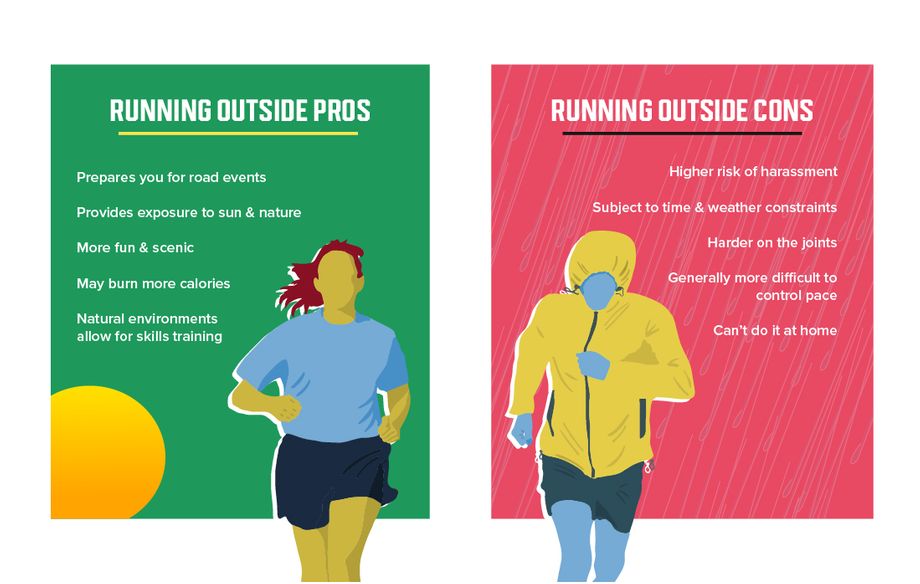
Pros:
First, we’ll take a look at the advantages of an old-fashioned outdoor jog.
May Burn More Calories
If you’ve noticed that running outside feels harder than running on a treadmill, you’re onto something. While there’s no concrete evidence that outside running objectively burns more calories than treadmill running, experts tend to agree that the elements of nature present an opportunity for more calorie burn.
“Heat and hills are two primary elements that force the body to work harder during a run,” Penner explains, “and a strong headwind can completely change the game. It’s akin to pulling a parachute behind you, and combined resistance and aerobic training is objectively proven to burn more calories than aerobic training alone.”
Other elements, such as the type of surface you’re running on, can also increase your energy output. Sand, for instance, requires much more power to run on than pavement, due to the lack of bounce-back.
Prepares You for Road Events
If you run to prepare for races, you really should be running outside for at least some of your training, Penner says.
“You’ll be really unhappy and uncomfortable if you exclusively train on a treadmill and then have to run an entire 10K, half marathon, or other race on a road with hills, turns, varied terrain, headwinds, and heat from the sun,” he says.
On a treadmill, the only outdoor element you can truly mimic is incline, but that alone won’t prepare you for everything else you may face during an outdoor race.
Provides Exposure to Sun and Nature
Studies show that spending time in nature makes big positive impacts on physical and emotional wellness, as does physical activity. One study published in Frontiers in Psychology suggests that exercising outdoors may bring additional benefits compared to exercising indoors.
Being outdoors is known to alleviate stress, reduce anxiety, and improve your ability to focus. These benefits have been objectively measured with physiological markers like blood pressure and cortisol levels.
By taking your runs outside, you’re compounding these benefits with the effects of exercise, including: cardiovascular and musculoskeletal health, mood regulation, sleep quality, and much more.
Generally More Fun and Scenic
I don’t know about you, but I enjoy running a lot more when I have stuff to look at. Running on the beach, along a palm-lined shore, or through the mountains is much more fun than running on a treadmill, staring at a display screen—even if it’s a fancy touchscreen one with interactive programming. Nothing is as interactive as just getting out there!
Natural Environments Allow for Skills Training
Try as treadmill companies might, a treadmill will never mimic the natural environment. When you run outside, you face varied terrain, naturally undulating inclines and declines, wind resistance, and much more.
“Running outdoors provides ample opportunity for developing skills such as breath control, pace management, stride changes, and more,” Penner says. “Plus, all of these natural elements help strengthen lateral stabilizers in the muscles that move the ankles, knees, and hips, reducing future risk for injury.”
Cons:
As you can see, there are so many positives to running outside. But it isn’t all rainbows, all the time. Here’s a look at the disadvantages of outdoor running.
Higher Risk of Harassment
This is something no one wants to talk about, but it’s important. Running outdoors, especially as a woman, poses an innate risk of harassment and other crimes. Of course, there are things you can do to keep yourself safe, such as:
- Running only on well-trafficked and well-lit roads
- Running with a dog or a friend
- Wearing bone-conduction headphones or leaving one earbud out
- Sharing your location with someone and keeping your phone on your person
- Running only in daylight hours
However, even in broad daylight, the risk remains, and it’s important to stay vigilant if you run outdoors.
Subject to Time and Weather Constraints
Picture this: You have an outdoor run planned, and you’re stoked about it. But when it’s time to step outside, the skies open up and, well, that’s that.
Sure, you could wear a rain jacket and pop your phone into a waterproof bag, but does anyone really want to deal with soggy socks? I’m going to go ahead and say no. Rainstorms, snow and ice, extreme heat, and other weather conditions can really throw a wrench in running plans.
Time of day affects many outdoor runners, too, since it’s not safe to run in the dark—morning or night—in many locations.
Harder on the Joints
Contrary to popular belief, running hasn’t been proven as a culprit for bad knees later in life. Quite the contrary, according to a 21-year-long study that correlates habitual running with a lower risk of disability as an older adult.
RELATED: Best Treadmills for Seniors
That said, anecdotal evidence is sometimes the best evidence. Pavement doesn’t have supportive cushioning like treadmill decks do, so many people find road running tougher on the ankles, knees, and hips than treadmill running.
Penner says if you want to run outdoors but find it too hard on your joints, try to choose softer surfaces. For example, run in the grass along a sidewalk instead of the sidewalk itself.
“Grass, hard-packed sand, and dirt trails absorb more shock than pavement does,” Penner says. “Even gravel can be better than pavement for those with sensitive joints, although gravel running can be tougher if the surface is too loosely packed.”
Generally More Difficult to Control Pace
Unless you wear a watch that shows your pace on a screen, it’s pretty much impossible to know your true pace while running outside. Even if you do wear a fitness tracker, maintaining your pace on the road is hard because you’re subject to wind, hills, and navigating other pedestrians and intersections if you’re in a city.
“To better control your pace during an outdoor run, choose locations where there are no cars, such as a trail in a park,” Penner says. “This way, you don’t have to stop for red lights and can keep up your momentum.”
There’s no way to control the other elements, such as wind and terrain, though, so maintaining pace through those must come with practice.
Can’t Do It at Home
Obviously, running at home is not an option if you choose to run outside. This isn’t a drawback if you live in a safe, scenic location, but for some people, running inside at home is simply safer. Plus, if you have children, running outside presents the need for childcare or timing your runs around school schedules.
Running on a Treadmill Pros and Cons
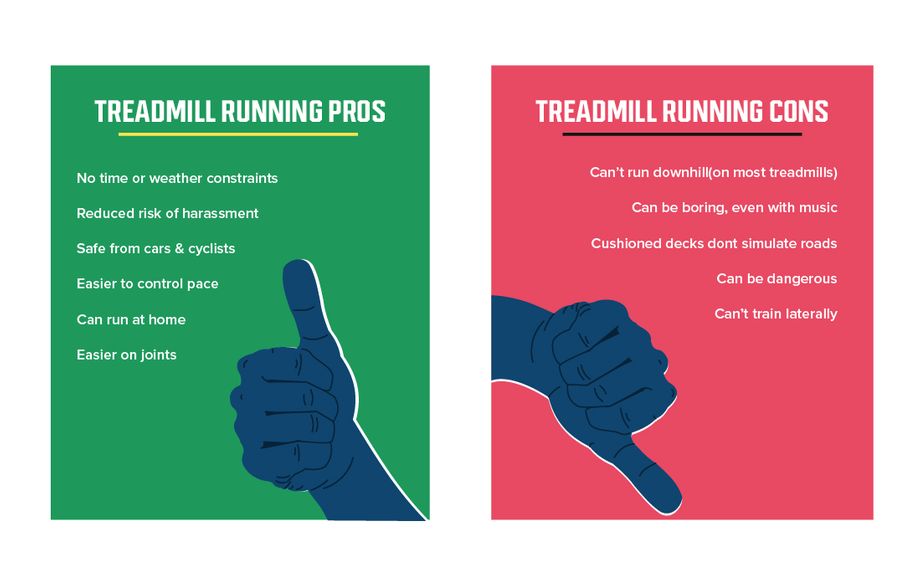
Now that we’ve discussed the major pros and cons of running outside, let’s look at some benefits and drawbacks of running on a treadmill.
Pros:
Just like outdoor running has its positives and negatives, so does treadmill running.
No Time or Weather Constraints
If you have access to a treadmill, whether in your home gym or at a commercial gym, you can run any time you like. If you like to run in the early mornings before work or late at night, you needn’t worry about running in the dark; likewise, if inclement weather arises, no worries!
RELATED: Best Home Treadmill for Running
“In this way, treadmills can actually help runners stay more consistent,” Penner says, “as opposed to outdoor running, where timing and weather can quickly get in the way of your planned run.”
Reduced Risk of Harassment
Inside, you’re less likely to fall victim to the leering of passers-by.
The risk isn’t nonexistent at gyms—in fact, gym harassment is grossly common—but the odds of tragic events happening are lower than running roadside.
Having a treadmill at home is the only nearly guaranteed way to feel safe while running.
Safe From Cars and Cyclists
In addition to being safe from hagglers, treadmill runners also remain safe from drivers and bicyclists who may not be paying attention to pedestrians. It’s just you and the ‘mill, which means it’s safer to zone out and jam out to your favorite music or listen to podcasts.

Easier to Control Pace
There are many treadmill benefits you can benefit greatly from if you tend to go out the gate too quickly on outdoor runs, petering out before you finish your planned mileage.
“Many runners find it difficult to maintain a solid, sustainable pace from the start of the runs,” Penner says. “On a treadmill, you must manually use the controls to slow down or pick up the pace, so you have to actually put some thought into it. This is useful for people who want to target specific paces during different runs.”
RELATED: Read our NordicTrack EXP7i treadmill review.
Can Run at Home
Booyah! A treadmill is an amazing investment for a home gym, especially one with interactive programming such as iFIT that also allows you to stream strength workouts. You can work out whenever and blast your music as loud as you want.
RELATED: Best Treadmill Workouts
Easier on Joints
The vast majority of treadmills have cushioned running decks to absorb shock and impact. For people who have past injuries, joint conditions like arthritis, or generally struggle with sensitive joints, cushioned decks can help relieve pain and pressure compared to outdoor running.
“Deck cushioning is one aspect of treadmills that makes them more accessible than outdoor running for certain groups of people,” Penner says. “Not everyone lives near soft running surfaces, like dirt trails, and pounding the pavement is too intense for some people no matter how good their running shoes are.”
RELATED: How to Choose Running Shoes
Cons:
Lastly, let’s take a look at the downsides of treadmill running.
Can’t Run Downhill (on Most Treadmills)
The majority of treadmills have incline settings between 10 and 15 percent grades, but few have decline settings, so it’s impossible to mimic downhill running on most treadmills.
“If you’re preparing for a road race, especially one in a mountainous region, running only on a treadmill won’t prepare you for the downhill portions,” Penner says. “This isn’t to say running on a treadmill can’t or won’t help you prepare for a race, but I recommend supplementing treadmill running with some outdoor running for this reason.”
(If you’re not running to race, or you race in places with flat, mostly level ground, this is a non-issue.)
Cushioned Decks Don’t Simulate Road Environment
Some newer, high-tech treadmills provide an off switch for deck cushioning, so you can mimic the feel of pavement on your treadmill runs. However, most treadmills still don’t have this feature, so you’ll be in for a shock if you only run on treadmills and then switch to the road.
As I pointed out above, deck cushioning is a good thing for a lot of reasons and is helpful for people with joint problems. But, should you ever want to transition from treadmill running to outdoor running, it’s worth pointing out that there will be an adjustment period.
Can be Super Boring, Even With Music
Even with the best workout playlist in the world, running on a treadmill can be maddeningly monotonous.
“Many people are simply more motivated to run outdoors due to scenery and fresh air,” Penner says, “while treadmill running feels much more like a chore.”
Experts always say: The best exercise is the type you’ll do consistently, so if treadmill running bores you to death, it’s probably not the right choice for you.
Treadmills Can Be Dangerous
Treadmills are considered one of the more dangerous pieces of cardio equipment due to their motors and moving belts. The U.S. Consumer Product Safety Commission estimates that there are, on average, 3 treadmill-related deaths per year, and The Washington Post reports that consumers faced more than 22,000 treadmill incidents in 2019 alone.
Practicing treadmill safety is vital to your well-being and the well-being of your pets, children, and/or housemates if you run on a treadmill at home.
Can’t Train Laterally
On a treadmill, you’re limited to the dimensions of the running deck, which generally fall about 50 to 60 inches long and 20 to 22 inches wide.
“Unlike a road or trail that winds and presents obstacles such as stones, tree roots, and other people, a treadmill only allows you to run perfectly straight and in forward motion,” Penner says. “Running outdoors presents an opportunity to better develop proprioception, which is the awareness of your body’s position and movement. Generally, better proprioception leads to better lateral, or side-to-side, movement patterns.”
Running Outside vs. Treadmill: Making Your Decision
So, does where you run really matter?
According to Penner, it depends on your goals and any health needs.
“If all you’re trying to do is stay healthy and keep up with your cardiovascular fitness, I encourage you to run anywhere that feels comfortable for you,” Penner says. “This is especially true for people with arthritis or other health conditions that may make outdoor running painful or impossible.”
He continues: “If you’re training for an outdoor race or want to incorporate different elements of resistance into your cardio, then outside running is the best option.”
RELATED: Exercise Bike vs Treadmill
Running Outside vs. Treadmill FAQs
Does running outside or on a treadmill burn more calories?
While there’s no concrete evidence that running outside burns more calories than running on a treadmill, some experts hypothesize that the elements of nature—wind resistance, heat, rugged terrain—results in more calories burned per hour at the same pace.
Penner says it more so comes down to pace and body mass: “The faster the pace, generally the more calories burned. The same goes for body weight. A heavier person running the same pace as a lighter person will burn more calories, and that’s just physics.”
How can a beginner start running outside?
Running is as simple as getting outside and putting one foot in front of the other. There are some things a beginner should do before running outdoors:
Purchase a pair of well-fitting, comfortable running shoes
Buy appropriate running attire (something that wicks sweat and allows for full mobility)
Wear reflective clothing or a reflective vest if you’re running without full sunlight
Hydrate before heading out
Map out a safe route
Try to find a running buddy or join a local running group
Share your location with a friend and keep your phone on you
Start small: Don’t do too much, too fast. New runners may find it helpful to start with interval running, which refers to the practice of running for a short time period followed by a rest interval. You could, for example, run for 30 seconds and walk for 1 minute, repeating until you hit your mileage goal.
Which incline level is closest to running outside?
Because there are so many factors that affect outdoor running and terrain is so varied across regions, there’s no concrete recommendation as to what incline level on a treadmill most closely mimics outdoor running.
However, Penner recommends bumping the incline up to level one or two in order to undo the propulsion of the running belt. “The motor and belt naturally propel you forward a bit during your stride, so slightly increasing the incline better mimics the resistance you’ll feel when running outside,” he says.
Can you train for a 5K on a treadmill?
Sure, you can train for a 5K race on a treadmill in terms of developing cardiovascular endurance. It’s best to mix in some road running to make sure you’re fully prepared for race day, but Penner says most people can adequately prepare for a 3.1-mile race on a treadmill.
Can you train for a marathon on a treadmill?
Training for a half or full marathon on a treadmill is a lot tougher than training for a shorter race, such as a 5K or 10K, on a treadmill only. Not only do marathons cover more ground—thus presenting a larger chance for inclines, declines, and tough terrain—but you have to battle the mental aspect of treadmill running.
“Plain and simple, most people don’t have it in them to train for a 26-mile race on a treadmill alone,” Penner says. “It’s repetitive and the majority of trainees will get bored before they reach the peak of a marathon training plan. Varying your training environment and running routes is a great way to stay consistent and keep training exciting.”
Why is running on a treadmill easier than running outside?
Running on a treadmill feels easier than running outdoors for a few reasons. First, there’s no wind resistance or precipitation.
Second, treadmills are generally placed in temperature-controlled environments, so you’re not dealing with extreme heat or cold.
Finally, the belt of a treadmill propels you forward a small amount, which makes it easier to take longer, quicker strides compared to running outside.


